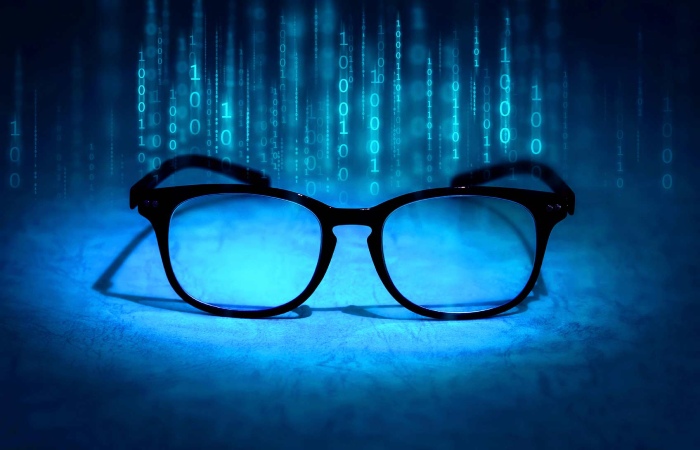Table of Contents
Digital Blue Light
Nowadays, our eyes are bare to digital blue light emitted by computer monitors and mobile phones or tablets. The number of hours we spend in front of devices that emit blue light increases, not because we spend more time in front of the computer, but because we are exposed to blue light more, in intermittent periods, between all the different devices.
We cannot consider life without them, but excessive use or without proper protection can end up irreparably damaging our eyes. These devices emit a large amount of blue-violet light, which is harmful to our eyes, and we also use them at short distances, so we put a greater demand on our eyes, and they age faster. It’s called computer vision syndrome.
Which already affects one in 7 people. They also do not help to work with tiny, low-resolution screens or petite font sizes. In the case of children, their lens is much more permeable, which is why their retina hurts to a greater extent, so protection from UV rays and harmful blue-violet light is a fundamental health issue for children. One of the main consequences is myopia, especially at an early age. In addition, overexposure to blue light can have a long-term impact and cause certain visual diseases such as Macular Degeneration Associated with Age. More and younger people suffer from cataracts.
Take note of these tips:
- Use lenses designed for digital screens that relax against visual fatigue, whether the prescription is needed or not.
- Take pauses of 15 minutes every two hours when screens are actuality use.
- Look into the distance and blink every 15 minutes or so.
- Place the screen slightly lower than eye level without this position forcing you to lower your head (in this way, greater tear evaporation will achieve since the eyeballs will not be as exposed)
- The screen must be at a distance of 50 to 70 centimetres,
- Take eye pressure annually after age 40 and check the retina periodically if you are myopic.
What is the Digital Blue Light?
Blue light is part of the electromagnetic range that the human eye observes, being emitted both naturally through the sun’s rays and artificially by the electronic devices we use in our daily lives. The wavelength of blue light is between 380nm and 475nm, and although it is within the visible human spectrum, the most challenging part of this light, called blue-violet light, can be damaging after prolonged exposure. For this reason, being visible to blue light for longer than the optional time becomes dangerous for our eyes since it can damage the photoreceptors and retinal cells, having increasing and chronic effects.
Some of the problems caused by lengthy exposure to blue light are as follows:
Short term:
- Computer Visual Syndrome (VIS)
- Fatigue and visual stress
- Eye dryness
- Red eyes
- Decreased blink rate
- Headache
- Lack of concentration
Long-term:
- Disruption of circadian rhythms of sleep
- Damage to the retina accelerates the process of the appearance of macular degeneration (AMD), which can lead to blindness
- It helps the early formation of cataracts

How can we protect ourselves from the Blue Light?
To protect our eyes, lens manufacturers have designed clear blue light filters that reduce the excess of this type of light, dropping its intensity and thus helping to guard our vision. At the same time, they release eye fatigue. Improve sleep quality and provide retinal protection against phototoxicity, especially protecting the macula.
There are dissimilar types of blue light filters, which are as follows:
External or layered blue filter
It locates on the external surface of the lens; it has a palpable residual “blue” tone in the reflections and slightly yellows the white tones.
Internal or mass blue filter
it integrates into the mass of the lens itself. In this way, it manages to filter a more significant amount of blue light than layer filters. They have the advantage that they do not produce blue reflections nor leave a residual tone that alters the contrast of colours.
Combined blue filter
it is the mixture of the two previous filters for which it achieves the maximum possible filtration capacity.
Other methods to protect our vision from blue light
When we are in front of the screen of any electronic device, we must be aware of it and not overexpose ourselves to blue light unnecessarily. In addition to the use of blue filter lenses, we leave you with a series of recommendations that you can start carrying out now and that will help reduce the harmful effects of blue light:
Use the 20-20-20 technique when you work with the computer
This technique consists of resting your eyes successively and every 20 minutes, looking at infinity or a distance of at least 6 meters, for 20 seconds. In this way, we will considerably reduce visual fatigue.
Reduce the number of hours you spend in front of the screen of your devices
Although we know that the use of these devices can be essential for our work or study, it is crucial that we also take care of our vision. Try to use these devices the time strictly necessary, replacing them during leisure hours with other types of tasks. Such as reading a book or, better yet, outdoor activities that improve your eyesight and physical condition.
Use your devices properly
protect users’ vision, and most LED devices have a “night light” filter that reduces the screen’s brightness, giving it a more orange colouration and lowering the saturation of the colours. By activating this filter, you will reduce part of the radiation that reaches your eyes directly.
Conclusion
Use lenses designed for digital blue light that offers a relaxing effect against visual fatigue, whether the prescription is needed or not. Take pauses of 15 minutes each two hours when screens are actuality use. Look into the distance and blink every 15 minutes or so.

